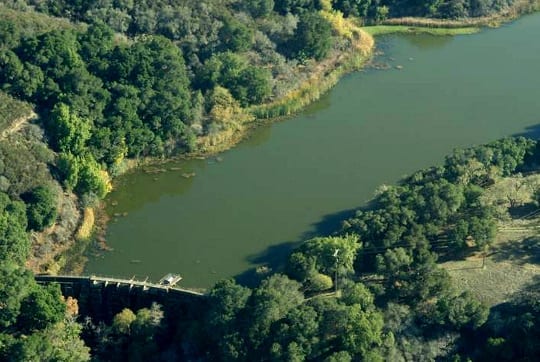Release: Stanford Investigated For Searsville Dam ESA Violations
Stanford Under Investigation for Possible Endangered Species Act Violations at Searsville Dam
Palo Alto — The National Marine Fisheries Service has launched an investigation into whether Stanford University’s operation of Searsville Dam has violated the Endangered Species Act by harming steelhead trout and other species threatened with extinction.
The dam blocks steelhead from migrating to almost 20 miles of historically accessible habitat upstream, it dewaters Corte Madera Creek below the dam, degrades water quality and habitat downstream and causes other negative impacts that harm threatened species.

The Searsville Dam blocks steelhead access and dewaters San Francisquito Creek.
For over a decade, American Rivers, members of the Beyond Searsville Dam coalition, CalTrout and other stakeholders have tried to work collaboratively with Stanford University to address the problems caused by their dam. The CA Dept of Water Resources even offered funding to investigate options to deal with the dam’s environmental liabilities. But Stanford ultimately rebuffed these efforts.
Stanford believes its dam is not subject to state or federal laws that protect fish and wildlife, as currently operated. Conservation groups disagree, and welcome NMFS’s investigation.
“While we’re disappointed that Stanford chose to take a path of resistance, avoidance, and lack of collaboration for so many years, we are happy to see that NMFS has decided that enough is enough and has opened an investigation into Stanford’s environmentally destructive dam. For years, Stanford had such a great opportunity to tap into local enthusiasm and funding for the benefit of the region and their own reputation” said BSD director Matt Stoecker.
“This investigation punctuates a decade of missed opportunities by Stanford. If the university had been a leader and innovator in its own backyard, the way it can be in any number of academic fields, they wouldn’t be in this mess. They can’t say we didn’t try to help.”
The NMFS investigation comes after years of requests from local groups that Stanford comply with state and federal laws, challenges to their controversial Habitat Conservation Plan and a State review of dam safety concern. Recently, Stanford began its Searsville Dam Alternatives Study, an internal process evaluating options for the dam’s future. The threat of an enforcement action against the university for ESA violations, which could include penalties, should motivate Stanford to complete its study process by the end of 2013, as promised.
Contacts:
Matt Stoecker – Beyond Searsville Dam, 650-380-2965
Steve Rothert – American Rivers, 530-277-0448





1 Comment
CalTrout- Thanks for your support of this important effort to make university’s lead by example and teach good stewardship.